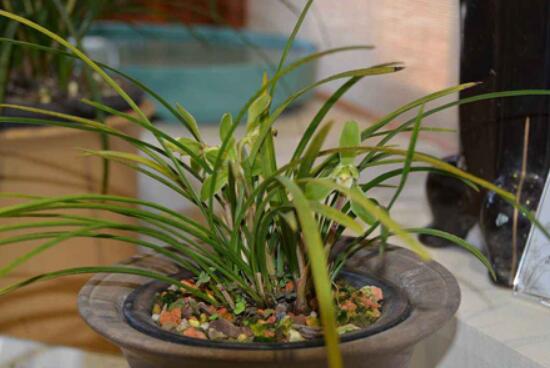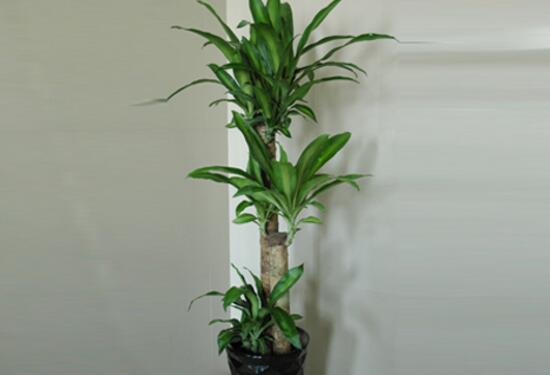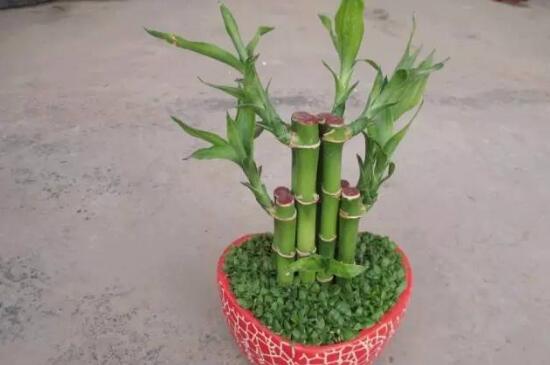How to propagate bluegrass, four propagation methods of bluegrass (cutting ramet is the most practical)
Orchid, that is, orchid, it is a traditional Chinese flower, with plum, bamboo, chrysanthemum and called four gentlemen, loved by the majority of flower friends. In life, many people keep bluegrass at home, but is a pot too monotonous? It's time to breed a few pots, so how does bluegrass reproduce? Here are four breeding methods of bluegrass, follow the editor to learn about it.
Cutting / ramet / sowing / tissue culture

To ask how to propagate bluegrass, there are four main methods: cutting, ramet, sowing and tissue culture. Among them, cutting is cutting the part with nodes on the orchid potted plant and inserting it into the soil; ramet is selecting the sturdy stem and planting it in the pot; sowing is to plant the bluegrass into the pot soil; tissue culture is to put the orchid bud into the culture nutrient solution and propagate rapidly.
2. Four propagation methods of bluegrass (1) Cuttage propagation of bluegrass
How does bluegrass reproduce? As a common indoor potted plant, cuttage can be used naturally. Operation: on the potted bluegrass, select the healthy stem, cut it off as cuttings with scissors at its joints (with nodes), and then insert it into the soil, which will soon grow roots, and then maintain it according to the cultivation method of bluegrass.
(2) ramet propagation of bluegrass.
When it comes to breeding bluegrass, the ramet is the most suitable for indoor flower friends, and the ramet is best to take off the pot to split the plant. Specific operation: before the ramet, appropriate watering, and then off the basin, select a sturdy stem (at least 5 connected pseudo-bulbs), pot planting can be.
Note: the divided flowerpot should first spread broken tiles, and then fill it with orchid like soil, preferably loose sandy soil, so as to ensure the permeability of the soil. After the ramet is completed, it is watered thoroughly, and then the soil is slightly moist, which can survive in half a month, and a new pot of bluegrass appears.
(3) sowing and propagation of bluegrass.
Orchid can get seeds after flowering, so the propagation method of bluegrass can also be sown. However, because there is only one underdeveloped embryo inside the orchid seed, the survival rate is low, and the orchid seed coat is not easy to absorb water, so the germination rate of orchid propagated by sowing method is very low. Therefore, the editor does not recommend that you use this method of reproduction.
(4) tissue culture propagation of bluegrass.
How does bluegrass reproduce? We can also use tissue culture method, which has the characteristics of high survival rate and low reproduction cost, but this method is generally used in large-scale production. Operation method: put the new buds of bluegrass into the culture nutrient solution, and a week later, the roots can be transplanted to water for cultivation.
Generally speaking, the propagation of bluegrass, whether it is cutting, ramet, sowing, or tissue culture, can be successful, but the most suitable for indoor florists is cutting and ramet. Of course, the method is dead, people are alive, we can choose according to the actual situation. With regard to the breeding methods of bluegrass, the editor has introduced this, hoping to give you some help.
Propagation methods of courtyard flowers in March
Propagation methods of courtyard flowers in March
The highest temperature of this month is 27.6 ℃ and the lowest is 5 ℃, with an average of 6.4 ℃, which is in the period of cold and warm alternation.
Propagation of flowers in the courtyard
1. Sowing seeds
The courtyard flowers that can be sowed in March are: crape myrtle, bauhinia, Chimonanthus chinensis, Chimonanthus chinensis, red maple and Liriodendron chinense. The last five kinds of seeds should be soaked in cold water for 24 to 36 hours before sowing. The species of flowers and trees that can be sown and raised by sand storage are: cycad, ginkgo biloba, bamboo cypress, Luohansong, Pukui, purple magnolia, Michelia, sweet-scented osmanthus, seven-leaf tree, Phyllostachys pubescens, holly, pomegranate, Qionghua and so on. Feasible sowing herbaceous flowers are: impatiens, marigold, thousand-day red, hundred-day grass, a string of red, cockscomb, colorful peppers, winter coral, spring, mallow, purple jasmine, magnolia, asparagus, asparagus and so on. Some species that are not resistant to cold should be sown in a plastic shed.
Propagation methods of courtyard flowers in March
two。 Cuttage
The flowers and trees that can be propagated by cutting in March are: Fusang, geranium, epiphyllum, Arrow lotus, Portulaca oleracea, gemstone, stone lotus, eight immortal flowers, southern bamboo, sticking begonia, silver bud willow, hypericum, Luohansong, pomegranate, fig, star anise plate, gardenia, Admiralty, welcome spring, emerald, Ruixiang, torch fruit, etc., afraid of cold flower cutting in the shed or indoor.
3. Grafting
The flowers and trees that can be grafted and propagated in March are as follows: using 1-2-year-old black pine seedlings as rootstocks, abdominal grafting to propagate five-needle pine, Osaka pine, golden pine and so on; 1-2-year-old Magnolia magnolia and Magnolia magnolia seedlings as rootstocks; 1-year-old peach and apricot seedlings as rootstock to cut and propagate plum blossom, Birthday Bun with Bean Paste Filling, green peach, red leaf peach and so on. When the leaf bud grows to the size of the wheat grain, the fine varieties of wax plum ear strips are selected, cut and bagged to keep the moisture, and the survival rate is higher; using the trigonous arrow as the rootstock, the grafted propagation of crab claw orchid and all kinds of fairy balls should be carried out in the greenhouse. In addition, camellia, cherry blossoms, sweet-scented osmanthus and red maple can also be grafted and propagated in March.
Propagation methods of courtyard flowers in March
4. Pressing strip
The species of flowers and trees that can be propagated by pressing in March are: Camellia, Camellia, plum blossom, wax plum, red maple, Luohansong, Cuibai, straight cypress, Michelia mollissima, pedicel begonia, snowball, gardenia, sweet-scented osmanthus, purple magnolia and so on.
5. Ramet
The flower species that can be propagated in March are: orchid, walnut peony, one-leaf orchid, asparagus, iron tree, southern bamboo, ten meritorious works, tapestry begonia, tiger tail orchid, purple triangular leaf sorrel, big flower canna, gorgeous ginger, dahlia, crane orchid and so on.
Flowers suitable for sowing and propagation in May, and it is not too late to grow flowers in May.
May is coming, and many flower lovers think that they have missed the best time to sow flowers, so they give up your side of planting and cultivating flowers. In fact, this is not necessary. Now there are succulent flower beds for everyone to summarize the flower planting in May.
The climatic feature of May is that the temperature continues to rise, and the rainfall in our country increases gradually from south to north. After each fall of Rain Water, the temperature increases obviously. The weather with many spring rains turns to muggy after the spring rain of Lesser Fullness of Grain ends, which marks the beginning of summer soon.
Therefore, May at the turn of spring and summer is a key period for growing flowers, which plays an important role in laying the foundation for the growth of potted flowers in summer and autumn.
Species of flowers and trees suitable for courtyard display
In May, at the turn of spring and summer, temperatures rise sharply across the country, and the sun is getting stronger and stronger. More species of potted ornamental plants can be displayed in the courtyard Such as rose, Nanyang fir, Tripterygium, Canadian jujube, rubber tree, five-needle pine, Luohan pine, southern bamboo, Zhu Dinghong, jasmine, palm bamboo, cycad, king coconut, sunflower, mottled clover tree, palm, wine bottle coconut, cinnamon, beautiful needle sunflower, European spring, lily, dwarf pot, pomegranate, peony, Michelia, red maple, Milan, four seasons cinnamon, daidai and so on.
Breeding of courtyard flowers:
1. Sowing seeds
The species of grass flowers suitable for sowing in May are: spring of the four seasons, impatiens, thousand-day red, and so on.
Woody flowers are loquat, star anise gold plate, broad leaf ten meritorious work, loose tail sunflower, wine bottle coconut, sweet-scented osmanthus. Among them, the seeds of the first five kinds of flowers can be sowed as they are picked, but the fruits of sweet-scented osmanthus, which are blackened, softened and whitened, should be stored in clean wet sand until February next year, and then sowed when the seeds are white.
When picking and sowing seeds, we should pay attention to the following points when sowing: first, to keep the seedbed moist, but not stagnant water; second, to cover the grass to prevent the seeds from "budding"; and third, to remove the covered grass 2 to 3 times after seed emergence, and set up a shed in time to shade the young.
In addition, although loquat is a large seed, but its bud top soil ability is weak, easy to bend, sowing too deep will affect the emergence rate and seedling rate, so it is appropriate to shallow sowing, generally ditch depth of 2 to 3 cm to cover soil to ditch full.
At this time, gladiolus bulbs planted in the ground can blossom in August. The evening jade planted in the ground can blossom from August to September.
two。 Cuttage
Herbaceous ornamental plants suitable for cutting in May are: red, pansy, chrysanthemum, duckweed, longkou flower, four seasons begonia, bamboo crabapple, tortoise back bamboo, cold water flower, taro, candle, white netting grass, thousand-day red, marigold, colored leaf grass, pepper grass, geranium, coral flower and so on.
Succulent ornamental plants include epiphyllum, lotus, cactus as rootstock, trigonous arrow as rootstock, stone lotus, gemstone flower and so on.
Woody ornamental plants are: rhododendron, pearl orchid, jasmine, tiger plum, rose, inverted golden bell, Fusang, dragon spitting pearl, southern bamboos, red back cinnamon, ten meritorious works, rubber tree, dragon blood tree, red mulberry, eight immortal flowers, pomegranate, hibiscus, five-colored plum, plantain, triangular plum, goose palm wood, firethorn, purple magnolia, drunken fish grass and so on.
3. Grafting
In May, wild rose and other rootstocks can be used as rootstocks to bud rose.
Magnolia was grafted with one-to two-year-old Magnolia seedlings or cuttings as rootstock.
The two-to three-year-old rubber tree was used as the rootstock, and the tree was grafted with flowers and leaves.
The seedlings of Acer truncatum were used as rootstock and the tender shoots were grafted onto Acer truncatum.
The seedlings of Chimonanthus praecox with thick fingers were used as rootstock to graft the excellent variety of Chimonanthus praecox.
Osmanthus fragrans seedlings or lobular privet were used as rootstock to graft Osmanthus fragrans.
Camellia oleifera or Camellia mono-petal seedlings were used as rootstocks and shoots were grafted onto camellia.
The vigorous growth of rhododendron was used as anvil to split the western rhododendron.
Using Artemisia annua as rootstock, grafted chrysanthemum
In early May, cactus and trigonous arrow were used as rootstock to graft crab claw orchid.
Take the three-rowed arrow as the rootstock, graft the peony and so on.
4. Ramet
The flower species that can be propagated separately in May are: Hosta, purple calyx, Iris, one-leaf orchid, onion orchid, crabgrass, twelve volumes, Guangdong evergreen, orchid, jasmine, pearl orchid, chrysanthemum, chrysanthemum, begonia, kidney fern and so on.
5. Pressing strip
The flowers that can be propagated by striping in May are: Michelia, Pearl Orchid, Plum Blossom, Spring, Rose, Begonia, Cherry Blossom, Magnolia, Rubber Tree, Belgian Rhododendron, Osmanthus fragrans, Magnolia, Leaf Tree, Luohan Pine, Cui Bai, Zhenbai, Gardenia, Wisteria, Lingxiao, Milan and so on.
- Prev

How do Brazilian iron trees reproduce? the propagation methods of Brazilian iron trees / two kinds of cuttings survive easily.
As a kind of foliage plant introduced from abroad, Brazilian iron tree can be said to be loved by flower friends in recent years. It is not only good-looking, but also has amazing effect in purifying air and beautifying home, so it has been propagated in large numbers. Different plants have different methods of reproduction, so how do Brazilian iron trees reproduce?
- Next

How to propagate Lily Bamboo and the method of Cuttage Propagation / rooting by cutting in Spring
For lily bamboo, we must be no stranger, it often appears in the form of water in the living room, office and other places, has an excellent ornamental. But is a pot of lily bamboo too monotonous? It's time to get a few more pots. If you don't buy it in the past, you might as well breed it yourself. How can lily bamboo breed?
Related
- Fuxing push coffee new agricultural production and marketing class: lack of small-scale processing plants
- Jujube rice field leisure farm deep ploughing Yilan for five years to create a space for organic food and play
- Nongyu Farm-A trial of organic papaya for brave women with advanced technology
- Four points for attention in the prevention and control of diseases and insect pests of edible fungi
- How to add nutrient solution to Edible Fungi
- Is there any good way to control edible fungus mites?
- Open Inoculation Technology of Edible Fungi
- Is there any clever way to use fertilizer for edible fungus in winter?
- What agents are used to kill the pathogens of edible fungi in the mushroom shed?
- Rapid drying of Edible Fungi

